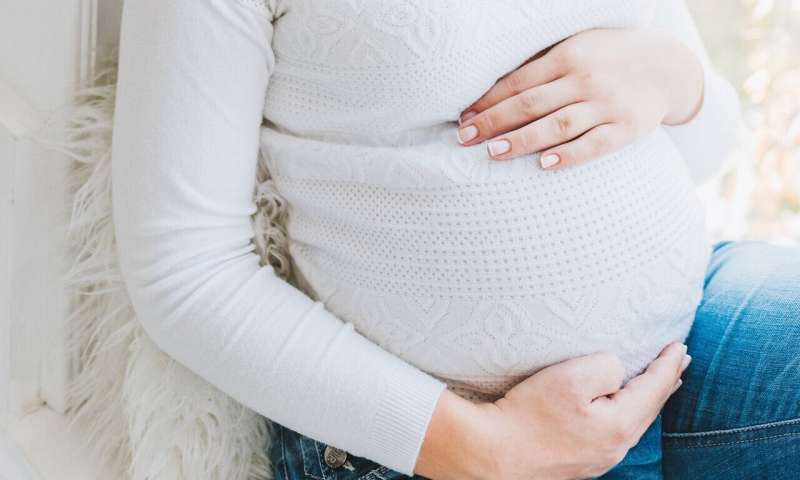Suicidal risk during pregnancy, after childbirth on the rise

Pregnancy and the period after delivering a baby can be one of the riskiest times for depressive symptoms, with suicide among the leading causes of death among new moms.
And now a new study suggests that suicide "near misses" during pregnancy and after childbirth are increasing.
The prevalence of suicidal thoughts and self-harm in the year before and after giving birth nearly tripled among childbearing people between 2006 and 2017, according to the findings in JAMA Psychiatry.
The greatest increases were seen among Black, low-income, and younger individuals, along with people with comorbid anxiety and depression or serious mental illness.
"Suicide deaths are a leading cause of maternal mortality in the U.S. It's a public health crisis that has silently grown worse," says lead author Lindsay Admon, M.D., M.Sc., an obstetrician-gynecologist at Michigan Medicine Von Voigtlander Women's Hospital and researcher with the University of Michigan Institute for Healthcare Policy and Innovation.
Researchers evaluated data from the Maternal Behavioral Health Policy Evaluation (MAPLE) study to evaluate suicidality trends among individuals aged 15-44 in the year before and following birth.
Of 595,237 commercially insured childbearing individuals across the U.S., 2,683 had either suicidal ideation or self-harm.
Maternal suicidality overall increased from 0.2 to 0.6 percent among people giving birth. That could translate to nearly 24,000 individuals among the estimated 4 million who give birth a year.
But these are likely underestimates, Admon says, since research suggests that depressive problems may be even higher among those who are on Medicaid—a population not included in the study.
Researchers identified concerning disparities too.
Particularly notable increases in suicidality were identified among those who were non-Hispanic Black, in younger age categories, and with the lowest household incomes. For instance, suicidality increased from affecting 0.2 to 0.9% of the non-Hispanic Black population over the study period, affecting 1% of the population by 2017.
Suicidality also increased from impacting 1.6 to 9.5% of those aged 15-18 over the study period, affecting 10% of the population by 2017.
The absolute greatest risks for suicidality appeared among those with serious mental health diagnoses and substance abuse disorders.
Identifying Maternal Suicidality
Suicide is the second leading cause of death among women 25-34 years of age, and has steadily increased in prevalence since 2001. However, mental health is not captured in data used to study maternal morbidity and mortality, which has increased in the U.S.
Researchers and national committees have examined "near misses" to understand how to prevent maternal death. But psychiatric near misses, such as suicidal ideation or intentional self-harm, remain excluded from standard severe maternal morbidity measures.
"Suicide in the perinatal period represents an important but understudied health outcome," says senior author Kara Zivin, Ph.D., professor of psychiatry and obstetrics and gynecology at the University of Michigan.
Numbers can be hard to pinpoint, she notes. Maternal mortality statistics reported by the Centers for Disease Control and Prevention (CDC) excludes suicide deaths, deeming them "incidental or accidental" rather than pregnancy-related.
But a report using data from 14 maternal mortality review committees documented suicide as comprising 8.8% of maternal deaths from 2008-2017.
The new research follows another recent U-M-led study finding that over the past decade (2006-2019), the prevalence of both perinatal mood and anxiety disorders and serious mental illness among delivering women increased substantially across the United States.
Women with these conditions experienced a higher incidence of severe maternal morbidity and mortality, and increased hospital transfers and lengths of stay.
"The increases and disparities in suicidality over time, and the likelihood that suicidality is both under detected and under treated remains concerning," says Zivin, also senior author on the previous study and who personally struggled with suicidality during her own pregnancy a decade ago.
"This research indicates we have more policy and clinical work to do to support struggling women and their families."
Pregnancy is an especially unique time when women are in more frequent contact with health providers, authors note, potentially increasing opportunities to identify depressive symptoms during pregnancy and postpartum.
"We need to improve screening for mental health wellness during and after pregnancy," Admon says. "We know that untreated mental health conditions put both moms and their children at higher risk for adverse health outcomes, including preterm birth and maternal suicide."
Policymakers, health plans, and clinicians should ensure access to universal suicidality screening and appropriate treatment for pregnant and postpartum individuals, particularly for high-risk groups, she says. Clinical and policy interventions should also be tailored to meet the specific needs of individuals.
"We need to seek health system and policy avenues to better identify suicidal symptoms in childbearing women, "Admon says. "It's critical that we intervene as early as possible and provide necessary therapies to reduce the risk of the most tragic outcome."
More information: Trends in Suicidality 1 Year Before and After Birth Among Commercially Insured Childbearing Individuals in the United States, 2006-2017," JAMA Psychiatry, DOI: 10.1001/jamapsychiatry.2020.3550


















